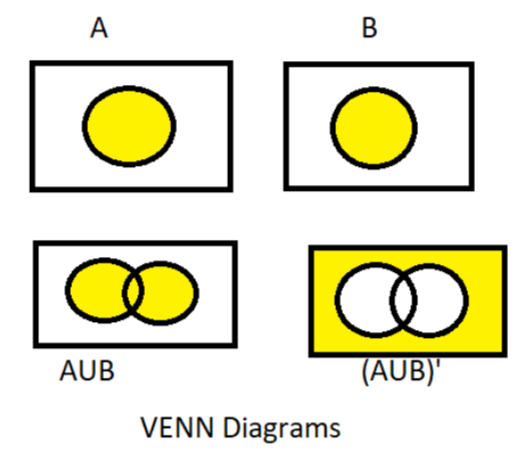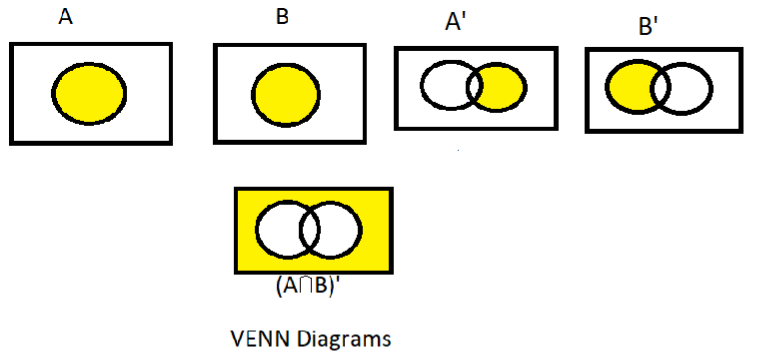
Use Venn diagrams to verify De’ Morgan’s law of complementation ${\left( {A \cup B} \right)^\prime } = \left( {A' \cap B'} \right)$
Answer
573.9k+ views
Hint: In this particular question use the concept that if set A has particular elements and set B has also some particular elements different from set A but some elements are same then in the set $\left( {A \cup B} \right)$ has all the elements containing set A and set B, common terms only written one time, in the set A’ there is no element which is in set A, so A’ is also called as a null set, so use these concepts to reach the solution of the question.
Complete step-by-step solution:
We have to verify using Venn diagrams De’ Morgan’s law of complementation i.e. ${\left( {A \cup B} \right)^\prime } = \left( {A' \cap B'} \right)$
I.e. complement of the union of the two sets is equal to the intersection of the complements of the respective set.
Now consider the LHS of the above equation we have,
$ \Rightarrow {\left( {A \cup B} \right)^\prime }$
Now as we know that if set A has particular elements and set B has also some particular elements different from set A but some elements are the same then in the set $\left( {A \cup B} \right)$ (i.e. A union B) has all the elements containing set A and set B, common terms only written one time, as shown in the Venn diagrams below.
Now ${\left( {A \cup B} \right)^\prime }$ is nothing but the complement of $\left( {A \cup B} \right)$ as shown in the Venn diagram below.

So ${\left( {A \cup B} \right)^\prime }$ is a null set i.e. a set which does not contain any elements.
Now consider the RHS of the above equation we have,
$ \Rightarrow \left( {A' \cap B'} \right)$
Now as we know that in set A’ there is no element of A as shown in the Venn diagram below similarly for the B’ or we can say that A’ and B’ is the complement of A and B respectively.
So A’ and B’ have no elements of A and B respectively.
So, $\left( {A' \cap B'} \right)$ has also no elements of A and B as shown below in the Venn diagrams.

So from the first and second Venn diagram, we can say that
LHS = RHS
Hence proved.
Note: Whenever we face such types of questions the key concept we have to remember is that always recall the following symbols which is given as,
$ \cup $ = union
$ \cap = $Intersection
$A'$ = complement of A
And the other De’ Morgan’s law is given as ${\left( {A \cap B} \right)^\prime } = \left( {A' \cup B'} \right)$
Complete step-by-step solution:
We have to verify using Venn diagrams De’ Morgan’s law of complementation i.e. ${\left( {A \cup B} \right)^\prime } = \left( {A' \cap B'} \right)$
I.e. complement of the union of the two sets is equal to the intersection of the complements of the respective set.
Now consider the LHS of the above equation we have,
$ \Rightarrow {\left( {A \cup B} \right)^\prime }$
Now as we know that if set A has particular elements and set B has also some particular elements different from set A but some elements are the same then in the set $\left( {A \cup B} \right)$ (i.e. A union B) has all the elements containing set A and set B, common terms only written one time, as shown in the Venn diagrams below.
Now ${\left( {A \cup B} \right)^\prime }$ is nothing but the complement of $\left( {A \cup B} \right)$ as shown in the Venn diagram below.

So ${\left( {A \cup B} \right)^\prime }$ is a null set i.e. a set which does not contain any elements.
Now consider the RHS of the above equation we have,
$ \Rightarrow \left( {A' \cap B'} \right)$
Now as we know that in set A’ there is no element of A as shown in the Venn diagram below similarly for the B’ or we can say that A’ and B’ is the complement of A and B respectively.
So A’ and B’ have no elements of A and B respectively.
So, $\left( {A' \cap B'} \right)$ has also no elements of A and B as shown below in the Venn diagrams.

So from the first and second Venn diagram, we can say that
LHS = RHS
Hence proved.
Note: Whenever we face such types of questions the key concept we have to remember is that always recall the following symbols which is given as,
$ \cup $ = union
$ \cap = $Intersection
$A'$ = complement of A
And the other De’ Morgan’s law is given as ${\left( {A \cap B} \right)^\prime } = \left( {A' \cup B'} \right)$
Recently Updated Pages
Why are manures considered better than fertilizers class 11 biology CBSE

Find the coordinates of the midpoint of the line segment class 11 maths CBSE

Distinguish between static friction limiting friction class 11 physics CBSE

The Chairman of the constituent Assembly was A Jawaharlal class 11 social science CBSE

The first National Commission on Labour NCL submitted class 11 social science CBSE

Number of all subshell of n + l 7 is A 4 B 5 C 6 D class 11 chemistry CBSE

Trending doubts
What is meant by exothermic and endothermic reactions class 11 chemistry CBSE

10 examples of friction in our daily life

One Metric ton is equal to kg A 10000 B 1000 C 100 class 11 physics CBSE

1 Quintal is equal to a 110 kg b 10 kg c 100kg d 1000 class 11 physics CBSE

Difference Between Prokaryotic Cells and Eukaryotic Cells

What are Quantum numbers Explain the quantum number class 11 chemistry CBSE




